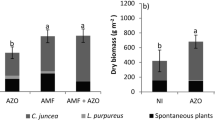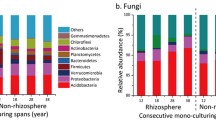Abstract
In the north of Spain, Cortaderia selloana plants have invaded ecosystems of high ecological value. Control of this species is carried out with the application of glyphosate-based formulations. The aim of this work was to determine, under microcosm conditions, the short-term (2 months) effects of the application of a glyphosate-based herbicide (Roundup®) on C. selloana rhizosphere microbial communities. To this purpose, before and after the application of Roundup®, several parameters that provide information on the biomass, activity and diversity of rhizosphere fungal and bacterial communities (enzyme activities, basal and substrate-induced respiration, potentially mineralizable nitrogen, nitrification potential rate, ergosterol content and community-level profiles with Biolog™ plates and ARISA) were determined. We observed a stimulation of some microbial parameters, in particular those related to fungal communities. Further research is needed to determine the long-term consequences of this short-term fungal stimulation for soil functioning.

Similar content being viewed by others
References
Accinelli, C., Koskinen, W. C., Seebinger, J. D., Vicari, A., & Sadowsky, M. J. (2005). Effects of incorporated corn residues on glyphosate mineralization and sorption in soil. Journal of Agriculture and Food Chemistry, 53, 4110–4117.
Alef, K., & Kleiner, D. (1996). Arginine ammonification, a simple method to estimate microbial activity potentials in soils. Soil Biology and Biochemistry, 18, 233–235.
Araújo, A., Monteiro, R., & Abarkeli, R. (2003). Effect of glyphosate on the microbial activity of two Brazilian soils. Chemosphere, 52, 799–804.
Bandick, A. K., & Dick, R. P. (1999). Field management effects on soil enzyme activities. Soil Biology and Biochemistry, 31, 1471–1479.
Barrutia, O., Garbisu, C., Epelde, L., Sampedro, M. C., Goicolea, M. A., & Becerril, J. M. (2011). Plant tolerance to diesel minimizes its impact on soil microbial characteristics during rhizoremediation of diesel-contaminated soils. Science of the Total Environment, 409, 4087–4093.
Cardinale, M., Brusetti, L., Quatrini, P., Borin, S., Puglia, A. M., Rizzi, A., Zanardini, E., Sorlini, C., Corselli, C., & Daffonchio, D. (2004). Comparison of different primer sets for use in automated ribosomal intergenic spacer analysis of complex bacterial communities. Applied and Environmental Microbiology, 70, 6147–6156.
De Maria, N., Becerril, J. M., García-Plazaola, J. I., Hernández, A., De Felipe, M. R., & Fernández-Pascual, M. (2006). New insights on glyphosate mode of action in nodular metabolism: role of shikimate accumulation. Journal of Agriculture and Food Chemistry, 54, 2621–2628.
Dick, R. P., Breakwell, D. P., & Turco, R. F. (1996). Soil enzyme activities and biodiversity measurements as integrative microbiological indicators. In J. W. Doran & A. J. Jones (Eds.), Methods for assessing soil quality (pp. 107–121). Madison: Soil Science Society of America.
Duke, S. O., & Powles, S. B. (2008). Glyphosate: a once-in-a-century herbicide. Pest Management Science, 64, 319–325.
Epelde, L., Becerril, J. M., Hernández-Allica, J., Barrutia, O., & Garbisu, C. (2008). Functional diversity as indicator of the recovery of soil health derived from Thlaspi caerulescens growth and metal phytoextraction. Applied Soil Ecology, 39, 299–310.
Gimsing, A. L., Borggaard, O. K., & Bang, M. (2003). Influence of soil composition on adsorption of glyphosate and phosphate by contrasting Danish surface soils. European Journal of Soil Science, 55, 183–191.
Gomez, E., Ferreras, L., Lovotti, L., & Fernandez, E. (2009). Impact of glyphosate application on microbial biomass and metabolic activity in a Vertic Argiudoll from Argentina. European Journal of Soil Biology, 45, 163–167.
Gong, P., Guan, X., & Witter, E. (2001). A rapid method to extract ergosterol from soil by physical disruption. Applied Soil Ecology, 17, 285–289.
Insam, H. (1997). A new set of substrates proposed for community characterization in environmental samples. In H. Insam & A. Rangger (Eds.), Microbial communities. Functional versus structural approaches (pp. 260–261). Heidelberg: Springer.
ISO 15685 Norm, (2004). Soil quality—determination of potential nitrification and inhibition of nitrification. Rapid Test by Ammonium Oxidation.
ISO 16072 Norm, (2002). Soil quality—laboratory methods for determination of microbial soil respiration.
ISO 17155 Norm, (2002). Soil quality—determination of abundance and activity of soil Microflora using respiration curves.
Kishore, S., & Jacob, G. S. (1987). Degradation of glyphosate by Pseudomonas sp. PG2982 via a sarcosine intermediate. The Journal of Biological Chemistry, 262, 12164–12168.
Kremer, R. J., Means, N. E., & Kim, S. (2005). Glyphosate affects soybean root exudation and rhizosphere micro-organisms. International Journal of Environmental Analytical Chemistry, 85, 1165–1174.
Krzysko-Lupicka, T., & Sudol, T. (2008). Interactions between glyphosate and autochthonous soil fungi surviving in aqueous solution of glyphosate. Chemosphere, 71, 1386–1391.
Lupwayi, N. Z., Hanson, K. G., Harker, K. N., Clayton, G. W., Blackshaw, R. E., O’Donovan, J. T., Johnson, E. N., Gan, Y., Irvine, R. B., & Monreal, M. A. (2007). Soil microbial biomass, functional diversity and enzyme activity in glyphosate-resistant wheat-canola rotations under low-disturbance direct seeding and conventional tillage. Soil Biology and Biochemistry, 39, 1418–1427.
MAPA-Ministerio de Agricultura, Pesca y Alimentación (1994). Métodos Oficiales de Análisis de Suelos y Aguas para Riego. Madrid: Secretaría General de Alimentación.
Mers, W., & Schinner, F. (1991). An improved and accurate method for determining the dehydrogenase activity of soils with iodonitrotetrazolium chloride. Biology and Fertility of Soils, 11, 216–220.
Mijangos, I., Becerril, J. M., Albizu, I., Epelde, L., & Garbisu, C. (2009). Effects of glyphosate on rhizosphere soil microbial communities under two different plant compositions by cultivation-dependent and -independent methodologies. Soil Biology and Biochemistry, 41, 505–513.
Muñoz-Leoz, B., Garbisu, C., Charcosset, J.-Y., Sánchez-Pérez, J. M., Antigüedad, I., & Ruiz-Romera, E. (2013). Non-target effects of three formulated pesticides on microbially-mediated processes in a clay-loam soil. Science of the Total Environment, 449, 345–354.
Powell, J. R., Levy-Booth, D. J., Gulden, R. H., Asbil, W. L., Campbell, R. G., Dunfield, K. E., Hamill, A. S., Hart, M. M., Lerat, S., Nurse, R. E., Pauls, K. P., Sikkema, P. H., Swanton, C. J., Trevors, J. T., & Klironomos, J. N. (2009). Effects of genetically modified, herbicide-tolerant crops and their management on soil food web properties and crop litter decomposition. Journal of Applied Ecology, 46, 388–396.
Powers, R. F. (1980). Mineralizable soil nitrogen as an index of nitrogen availability to forest trees. Soil Science Society of America Journal, 44, 1314–1320.
Ranjard, L., Nazaret, S., Gourbière, F., Thioulouse, J., Linet, P., & Richaume, A. (2000). A soil microscale study to reveal the heterogeneity of Hg(II) impact on indigenous bacteria by quantification of adapted phenotypes and analysis of community DNA fingerprints. FEMS Microbiology Ecology, 31, 107–115.
Ratcliff, A. W., Busse, M. D., & Shestak, C. J. (2006). Changes in microbial community structure following herbicide (glyphosate) additions to forest soils. Applied Soil Ecology, 34, 114–124.
Shugeng, F., Hongxun, Z., Yanfen, W., Zhihui, B., & Guoquiang, Z. (2009). Analysis of fungal community structure in the soil of Zoige Alpine Wetland. Acta Ecologica Sinica, 29, 260–266.
Taylor, J., Wilson, B., Mills, M., & Burns, R. (2002). Comparison of microbial numbers and enzymatic activities in surface soils and subsoils using various techniques. Soil Biology and Biochemistry, 34, 387–401.
ter Braak, C. J .F. and Šmilauer, P. (2012). Canoco Reference Manual and User’s Guide: Software for Ordination, version 5.0. Microcomputer Power, Ithaca, USA.
Tsui, M. T. K., & Chu, L. M. (2003). Aquatic toxicity of glyphosate-based formulations: comparison between different organisms and the effects of environmental factors. Chemosphere, 52, 1189–1197.
Welkie, D. G., Stevenson, D. M., & Weimer, P. J. (2010). ARISA analysis of ruminal bacterial community dynamics in lactating dairy cows during the feeding cycle. Anaerobe, 16, 94–100.
Yin, R., Deng, H., Wang, H., & Zhang, B. (2014). Vegetation type affects soil enzyme activities and microbial functional diversity following re-vegetation of a severely eroded red soil in sub-tropical China. Catena, 115, 96–103.
Acknowledgments
The authors acknowledge the support of research grant UPV/EHU-GV IT-299-07 from the Basque Government and the technical support provided by Azucena González from the Phytotron Service of UPV/EHU.
Author information
Authors and Affiliations
Corresponding author
Additional information
M. Anza and L. Epelde contributed equally to this study.
Rights and permissions
About this article
Cite this article
Anza, M., Epelde, L., Artetxe, U. et al. Control of Cortaderia selloana with a glyphosate-based herbicide led to a short-term stimulation of soil fungal communities. Environ Monit Assess 188, 631 (2016). https://doi.org/10.1007/s10661-016-5649-9
Received:
Accepted:
Published:
DOI: https://doi.org/10.1007/s10661-016-5649-9




